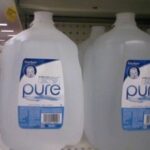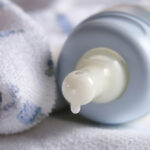Many breastfeeding moms, especially those who work, need to pump breastmilk for a caregiver to feed to baby with a bottle. Others feel the need to pump breastmilk and have a stash in the freezer in case of emergency. Storing breastmilk is a simple process, but certain guidelines must be followed to ensure that your breastmilk remains suitable for your baby.
Appropriate containers for storing breastmilk
There are a variety of containers available for storing breastmilk. Plastic breastmilk storage bags, such as those manufactured by Lansinoh or Gerber, are a popular option. These bags are inexpensive and easy to use. Some mothers, however, prefer glass containers because of the possibility of chemical transfer from plastic containers. Whatever type of container you prefer, remember to store breastmilk in small amounts, no more than four ounces to avoid wasting milk. Most moms find that one to two ounces is just the right amount.
Storing breastmilk at room temperature
In a normal room (66 to 72 degrees), pumped breastmilk can stay fresh for up to 10 hours. Higher temperatures will cause faster spoiling. If the breastmilk is intended for longer-term storage, it should be placed in the refrigerator or freezer as soon as possible.
Storing breastmilk in the refrigerator
Breastmilk can be stored in the refrigerator for up to 8 days. Refrigerated breastmilk should be kept at the back of the refrigerator away from the door. Do not store breastmilk in the door compartment of the refrigerator, as it will spoil faster.
Storing breastmilk in the freezer
Breastmilk can be stored in a freezer compartment inside a refrigerator (think dorm-style fridges or older refrigerators) for up to two weeks. In a traditional refrigerator/freezer combo where the freezer has a separate door, breastmilk can be stored for three to six months. In a separate chest freezer or deep-freeze, stored breastmilk can be kept for up to one year. In any type of freezer, breastmilk should be kept away from the door and sides of the freezer. Once frozen breastmilk is thawed, it must be used within 24 hours.
Adding freshly-pumped breastmilk to stored breastmilk
Freshly-pumped breastmilk can be added to breastmilk that is already in storage, provided that the fresh milk is cooled before adding to the already cooled milk. When adding fresh breastmilk to a container in the refrigerator, simply place the fresh milk in a separate container in the fridge for about 30 minutes to chill before adding to the previously-stored breastmilk.
The same rule applies for adding fresh breastmilk to frozen – place fresh milk in the refrigerator to chill for 30 minutes to one hour before adding to the frozen milk. This is especially important when adding fresh milk to frozen – if the fresh milk is not first chilled, it will partially thaw the already-frozen breastmilk. Once breastmilk (and most other foods) have thawed, refreezing is not recommended, so it is important to prevent that initial thawing so that your breastmilk doesn’t go to waste.
When adding fresh breastmilk to previously-stored breastmilk, use the date of the original portion as a guideline for storage.
Heating stored breastmilk
Breastmilk may be warmed by holding the container under running warm water, or with a bottle warmer. Frozen milk should be thawed overnight in the refrigerator, but may be thawed under running water, starting with cool water and gradually increasing the temperature. Never heat breastmilk in the microwave or directly on the stove, as this can cause “hot spots” and break down essential nutrients.
How to tell if stored breastmilk has gone bad
The best way to tell if your breastmilk has spoiled is to smell it or taste it. It should smell and taste sweet, not bitter or sour. If you’ve ever smelled spoiled cow’s milk, you know the sour smell that comes with spoiling – spoiled breastmilk will have the same smell. Some mothers find that their stored breastmilk has a slightly soapy taste – this does not indicate spoiled milk, but rather an excess of an enzyme called lipase. This is natural, and not harmful to baby, although he may reject the milk if the taste is too strong.
Breastfeeding mothers often take their stored breastmilk out of the freezer to find that it has separated. Too often, these moms mistakenly believe that this is a sign of spoiled breastmilk, and throw it out. But every mammal’s milk will separate in this way when stored. Even cow’s milk will separate when left alone. However, most milk that we buy at the grocery store has undergone the process of homogenization, which prevents this separation. Separation is normal, and is not a sign of spoiled breastmilk. (Note: when mixing separated breastmilk to give to baby, do not shake the milk. Shaking can cause a breakdown of the fats and nutrients. Instead, swirl gently until the breastmilk is mixed.)
Color is also not a factor in determining whether your stored breastmilk is suitable for your baby. Human milk ranges in color from yellow to pinkish to bluish and other shades, and it’s all perfectly normal. Color often varies according to the mother’s diet.
When in doubt, offer the breastmilk to your baby. A baby has strong instincts, and will not drink spoiled milk. Just as your pet dog or cat will not eat rotten meat, a baby knows when his milk has gone bad, and will refuse to drink it. If your baby seems reluctant to drink and you have reason to suspect that the milk may have gone bad, it probably has. Throw it out.
For more information on breastmilk handling and storage, please refer to the links at the bottom of this article.
If you enjoyed this article and would like to read more by this author, please click on the picture of the baby’s bottom next to the author’s name.




